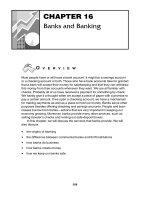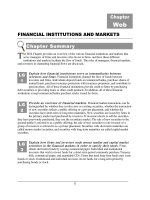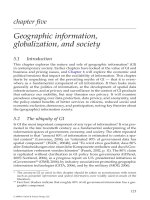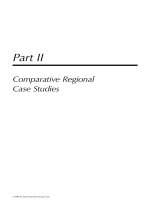NANCIAL INSTITUTIONS AND MARKETS Chapter Web pot
Bạn đang xem bản rút gọn của tài liệu. Xem và tải ngay bản đầy đủ của tài liệu tại đây (200.92 KB, 12 trang )
11
FINANCIAL INSTITUTIONS AND MARKETS
Chapter Summary
he Web Chapter provides an overview of the various financial institutions and markets that
serve managers of firms and investors who invest in firms, and how these different
institutions and markets facilitate the flow of funds. The roles of managers, financial markets,
and investors in channeling financial flows are discussed.
Explain how financial institutions serve as intermediaries between
investors and firms.
Financial institutions channel the flow of funds between
investors and firms. Individuals deposit funds at commercial banks, purchase shares of
mutual funds, purchase insurance protection with insurance premiums, and contribute to
pension plans. All of these financial institutions provide credit to firms by purchasing
debt securities or providing loans or other credit products. In addition, all of these financial
institutions except commercial banks purchase stocks issued by firms.
Provide an overview of financial markets.
Financial market transactions can be
distinguished by whether they involve new or existing securities, whether the transaction
of new securities reflects a public offering or a private placement, and whether the
securities have short-term or long-term maturities. New securities are issued by firms in
the primary market and purchased by investors. If investors desire to sell the securities
they have previously purchased, they use the secondary market. The sale of new securities to the
general public is referred to as a public offering; the sale of new securities to one investor or a
group of investors is referred to as a private placement. Securities with short-term maturities are
called money market securities, and securities with long-term maturities are called capital market
securities.
Explain how firms and investors trade money market and capital market
securities in the financial markets in order to satisfy their needs.
Firms
obtain short-term funds by issuing commercial paper. Individual and institutional
investors that wish to invest funds for a short-term period commonly purchase Treasury
bills, commercial paper, and negotiable CDs. Firms that need long-term funds may issue
bonds or stock. Institutional and individual investors invest funds for a long-term period by
purchasing bonds or stock.
Chapter
Web
T
LG
1
LG
2
LG
3
Web Chapter, Financial Institutions and Markets
12
Describe the major securities exchanges.
The major securities exchanges are the
New York Stock Exchange and the NASDAQ-AMEX exchange. The stocks of the
largest U.S. publicly traded firms are typically traded on the New York Stock Exchange,
whereas stocks of smaller firms are traded on the NASDAQ-AMEX exchange.
Describe derivative securities and explain why they are used by firms and
investors.
Derivative securities are financial contracts whose values are derived from
the values of underlying financial assets. They are commonly used by firms to reduce
their exposure to a particular type of risk. Investors may use derivative securities to
enhance their returns or reduce their exposure to some types of risk.
Describe the foreign exchange market.
The foreign exchange market is composed
of the spot market and the forward market. The spot market makes possible the
immediate exchange of one currency for another at the prevailing exchange rate (spot
rate). The forward market allows for the negotiation of contracts (forward contracts) that
specify the exchange of an amount of one currency for at a particular future date and at a
particular exchange rate (the forward rate).
Chapter Outline
Financial Institutions
Financial institutions serve as intermediaries by channeling the savings of individuals,
business, and governments into loans and investments. The primary suppliers of funds to
financial institutions are individuals; the primary demanders of funds are firms and
governments.
The major financial institutions in the United States are the commercial banks and other savings
institutions, mutual funds, securities firms, insurance companies, and pension funds.
1. Individuals deposit funds at commercial banks, which use the deposited funds to
provide commercial loans to firms and personal loans to individuals, and purchase debt
securities issued by firms or government agencies. Commercial banks act as
intermediaries by consolidating small deposits of individuals into large loans for firms,
and by assessing the creditworthiness of the firms wishing to borrow funds and
diversifying the loans across several borrowers on behalf of the depositors. Because of
their unique position in the economy, banks are regulated (by the Federal Deposit
Insurance Corporation, the Federal Reserve Board, and others) to help promote
competition among banking institutions and to limit the risks banks take on. The goal of
LG
4
LG
5
LG
6
LG
1
Web Chapter, Financial Institutions and Markets
13
regulation is for bank customers to be charged reasonable prices for the services they
obtain, while maintaining the stability of the financial system.
2. Individuals purchase shares of mutual funds, which use the proceeds to invest in
securities. Mutual funds are owned by investment companies and enable small
investors to enjoy the benefits of investing in a diversified portfolio of securities
purchased on their behalf by professional investment managers.
3. Individuals may also use the services of securities firms, a category of firms that
includes investment banks, investment companies, and brokerage firms. Securities
firms serve as intermediaries by (a) helping firms and government agencies place (sell)
securities with investors and (b) helping investors buy or sell securities.
4. Individuals purchase insurance (life, property and casualty, and health) protection with
insurance premiums. The insurance companies pool these payments and invest the
proceeds in various securities until the funds are needed to pay off claims by
policyholders. Because they often own large blocks of a firm’s stocks or bonds, they
frequently attempt to influence the management of the firm to improve the firm’s
performance, and ultimately, the performance of the securities they own.
5. Individuals make contributions to pension plans, either directly or through their
employer, which then invest the proceeds on behalf of the employees. Pension plans
also often own large blocks of a firm’s stocks or bonds and, like insurance companies,
are likely to be active shareholders
Two major changes taking place in the financial markets and institutions areas are consolidation
and globalization. The consolidation of financial institutions is leading to large financial
conglomerates offering a wide range of financial services. Globalization has occurred as barriers to
various forms of international commerce are making it easier and more profitable to engage in
international financial activities.
Financial Markets
Financial market transactions can be distinguished by whether they involve new or
existing securities, whether the transaction of new securities reflects a public offering or a
private placement, and whether the securities have short-term or long-term maturities.
New securities are issued by firms in the primary market, and purchased by investors. If
investors desire to sell the securities that they previously purchased, they use the secondary market.
The sale of new securities to the general public is referred to as a public offering and the first
offering of stock is called an initial public offering. The sale of new securities to one investor or a
group of investors (institutional investors) is referred to as a private placement.
Securities with short-term maturities (1 year or less) are called money market securities, while
securities with longer-term maturities are called capital market securities.
There are also important debt and equity markets outside of the United States. The Eurobond
market allows large corporations or governments to issue bonds denominated in dollars but sold to
LG
2
Web Chapter, Financial Institutions and Markets
14
investors located outside of the United States. Alternatives to Eurobonds are foreign bonds, which
are bonds sold in foreign countries but denominated in the country’s home currency. The
international equity markets have also grown in importance, making it easier for large firms to raise
equity capital in more than one country and for governments to sell their state-owned companies to
private investors.
Money Market Securities
Treasury bills are short-term debt securities issued in maturities of 13 weeks, 26 weeks,
and one-year by the U.S. Treasury. Their par value (principal to be paid at maturity) is a
minimum of $10,000 and they are sold at a discount from the par value.
Commercial paper is a short-term debt security issued by well-known, creditworthy firms
that serves as an alternative to a short-term loan from a bank. Like Treasury bills, it is sold at a
discount from par; unlike Treasury bills, investors are subject to default risk on their investment so
the required return on commercial paper is slightly higher than on Treasury bills.
Negotiable certificates of deposits (NCDs) are short-term debt securities issued by financial
institutions. Like commercial paper, the required returns on NCDs are slightly above the return on
Treasury bills. Unlike Treasury bills and commercial paper, NCDs provide interest payments and
are not sold at a discount.
Firms and investors can also use foreign money markets to borrow or invest funds for short-term
periods, perhaps enjoying lower financing costs or higher investment returns than comparable U.S.
investments.
Capital Market Securities
Bonds are long-term debt securities issued by firms and governments to raise large amounts of
long-term funds.
1. Treasury bonds are issued with typical maturities of 10 to 30 years by the U.S.
Treasury and generally pay interest every six months. They are often referred to as
risk-free investments since they are backed by the federal government. There is a very
active primary and secondary market in the trading of Treasury bonds.
2. Municipal bonds are issued by municipalities to support their expenditures and can be
either general obligation bonds (backed by the municipality’s ability to tax) or revenue
bonds (with repayment made from the funds generated by the project financed). The
interest paid on municipal bonds is exempt from federal income taxes so the cost of
funds to the municipalities and the pre-tax return to investors are lower than other
bonds. Interest is paid on a semiannual basis.
3. Corporate bonds are issued by corporations to finance their investment in long-term
assets, such as building or machinery. Typical maturities are from 10 to 30 years, and
interest is paid semiannually.
LG
3
Web Chapter, Financial Institutions and Markets
15
Common stock represents units of ownership interest, or equity, in a corporation. Common
stockholders expect to earn a return by receiving dividends, by realizing gains through the
increases in share prices, or both.
Preferred stock is a special form of ownership. Preferred stockholders are paid a fixed periodic
dividend before any dividends can be paid to common stockholders. Preferred stock thus has a
“preference” over common stock, much like bonds.
Major Securities Exchanges
Securities exchanges provide the marketplace in which firms raise funds through the sale
of new securities and in which purchasers of securities can maintain liquidity by being
able to resell them easily when necessary.
Organized security exchanges, most notably the New York Stock Exchange, are tangible
organizations that act as secondary (auction) markets in which securities are bought and sold. The
stocks of most large U.S. publicly traded firms are traded on the New York Stock Exchange.
The over-the-counter exchange (OTC), linked through the National Association of Securities
Dealers Automated Quote (NASDAQ) System, is an intangible market for the purchase and sale
of securities not listed on the organized exchanges and the primary market for selling all new public
issues.
Derivative Securities Ma rkets
Derivative securities (also called derivatives) are financial contracts whose values are
derived for the values of underlying financial assets. Examples of derivative securities are
stock options and financial futures.
Derivative securities are used by firms to reduce their exposure to a particular type of
risk. Investors may use them to enhance their returns (by speculating on future changes in the
prices of the underlying assets) or to reduce their exposure to different types of risk.
The Foreign Exchange Market
The foreign exchange market consists of large international banks around the world
buying and selling currencies to facilitate the international purchases of products,
services, and securities. It is composed of the spot market and the forward market.
The spot market enables immediate exchange of one currency for another at the prevailing
exchange rate (spot rate). The forward market allows for the negotiation of contracts
(forward contracts) that specify the exchange of an amount of one currency for another at a
particular future date and at a particular exchange rate (the forward rate).
LG
4
LG
5
LG
6
Web Chapter, Financial Institutions and Markets
16
Sample Problem Solutions
Sample Problem 1: Treasury Bill Returns
You are purchasing a 1-year Treasury bill with a par value of $10,000 and a price of $9,550. If you
hold the Treasury bill until maturity, how much will your return be?
Solution to Sample Problem 1
($10,000 - $9,550) / $9,550 = 4.71%.
Sample Problem 2: Foreign Exchange Calculations
Jones International must pay 200,000 Swiss francs for purchasing inventory from a Swiss firm.
Payment is due in one month. The one-month forward rate of the Swiss franc is $0.61, and Jones
expects the spot rate for the Swiss franc to be $0.62 one month from now. Should Jones use a
forward contract to buy the Swiss francs they need now or wait until next month to make their
payment of Swiss francs?
Solution to Sample Problem 2
If they wait and the spot rate for Swiss francs next month is as expected ($0.62), they will
need to make a total payment of $124,000 (200,000 x $0.62).
If they enter a contract to buy the Swiss francs in one month at today’s forward rate
($0.61), they will need to make a total payment of $122,000 (200,000 x $0.61).
By hedging with a forward contract, Jones expects to save $2,000.
Study Tips
1. Be sure to understand the differences between securities. Money market securities are used
to borrow funds (or invest) for a short amount of time and capital market securities are
generally used to borrow (or invest) for longer periods of time.
Web Chapter, Financial Institutions and Markets
17
2. The international financial markets are becoming increasingly important alternatives for
both borrowers and investors and need to be understood as well as their domestic
counterparts.
Sample Exam
True/False
T F 1. Primary and secondary markets are markets for short-term and long-term securities,
respectively.
T F 2. Financial markets are intermediaries that channel the savings of individuals,
businesses, and government into loans or investments.
T F 3. The money market involves trading of securities with maturities of one year or less
while the capital market involves the buying and selling of securities with maturities of
more than one year.
T F 4. A bond issued by a U.S. firm that is denominated in Swiss Francs and sold in
Switzerland would be an example of a foreign bond.
T F 5. Holders of equity have claims on both income and assets that are secondary to the
claims of creditors.
T F 6. Preferred stock is a special form of stock having a fixed periodic dividend that must be
paid prior to payment of any interest to outstanding bonds.
T F 7. Unlike the organized exchanges, the OTC handles both outstanding securities and new
public issues, making it both a secondary and a primary market.
T F 8. Commercial banks obtain most of their funds from borrowing in the capital markets.
T F 9. Credit unions are the largest type of financial intermediary handling individual savings.
T F 10. A mutual fund is a type of financial intermediary that obtains funds through the sale of
shares and uses the proceeds to acquire bonds and stocks issued by various business
and governmental units.
T F 11. IPO stands for Interest and Principal Obligation.
T F 12. The two primary types of municipal bonds are general obligation and revenue bonds.
T F 13. The forward exchange rate is the rate of exchange between two currencies at some
specified future date.
Web Chapter, Financial Institutions and Markets
18
T F 14. The spot exchange rate is the prevailing rate of exchange between two currencies.
T F 15. Derivative securities derive their values from underlying assets.
Multiple Choice
1. A ______ is the largest financial intermediary handling individual savings. It receives
premium payments that are placed in loans or investments to accumulate funds to cover
future benefits.
a. life insurance company
b. commercial bank
c. savings bank
d. credit union
2. The key participants in financial transactions are individuals, businesses, and governments.
Individuals are net ______ of funds, and businesses are net ______ of funds.
a. suppliers; demanders
b. purchasers; sellers
c. demanders; suppliers
d. users; providers
3. Which of the following is not a financial institution?
a. A pension fund
b. A newspaper publisher
c. A commercial bank
d. An insurance company
4. A ______ is set up so that employees of corporations or governments can receive income
after retirement.
a. life insurance company
b. pension fund
c. savings bank
d. credit union
5. A ______ is a type of financial intermediary that pools savings of individuals and makes
them available to business and government demanders. Funds are obtained through the sale
of shares.
a. mutual fund
b. savings and loans
c. savings bank
d. credit union
6. Most businesses raise money by selling their securities in
a. a direct placement.
b. a stock exchange.
c. a public offering.
Web Chapter, Financial Institutions and Markets
19
d. a private placement.
7. Which of the following is not a service provided by financial institutions?
a. Buying the businesses of customers
b. Investing customers’ savings in stocks and bonds
c. Paying savers’ interest on deposited funds
d. Lending money to customers
8. Government usually
a. borrows funds directly from financial institutions.
b. maintains permanent deposits with financial institutions.
c. is a net supplier of funds.
d. is a net demander of funds.
9. By definition, the money market involves the buying and selling of
a. funds that mature in more than one year.
b. flows of funds.
c. stocks and bonds.
d. short-term funds.
10. The ______ is created by a financial relationship between suppliers and demanders of
short-term funds.
a. financial market
b. money market
c. stock market
d. capital market
11. Firms that require funds from external sources can obtain them from
a. financial markets.
b. private placement.
c. financial institutions.
d. All of the above.
12. The two key financial markets are
a. money market and capital market.
b. capital market and secondary market.
c. primary market and secondary market.
d. primary market and money market.
13. Long-term debt of a business or corporation typically has maturities of between
a. 6 months and 1 year.
b.
1 and 5 years.
c. 5 and 20 years.
d. 10 and 30 years.
14. If a bond pays $1,000 plus interest at maturity, $1,000 is called the
a. par value.
b. long-term value.
c. stated value.
Web Chapter, Financial Institutions and Markets
20
d. market value.
15. ______ is hired by a firm to find prospective buyers for its new stock or bond issue.
a. A commercial loan officer
b. An investment banker
c. A securities analyst
d. A trust officer
16. The major securities traded in the capital markets are
a. stocks and bonds.
b. bonds and commercial paper.
c. commercial paper and Treasury bills.
d. Treasury bills and certificates of deposit.
17. International Advisors, Inc. (IAI) is receiving a payment of 100,000 Euros in three months.
The spot rate for the Euro is currently $0.92 per Euro, but IAI has entered into a three-
month forward contract with their bank at $0.94 per Euro. How much will IAI receive in
three months?
a. $92,000
b. $94,000
c. $106,383
d. $108,696
18. Long-term debt instruments used by both government and business are known as
a. bonds.
b. equities.
c. stocks.
d. bills.
19. The ______ stock exchange is a primary market where new public issues are sold.
a. regional
b. American
c. New York
d. over-the-counter
20. You are purchasing a 1-year Treasury bill with a par value of $10,000 and a price of
$9,600. If you hold the Treasury bill until maturity, how much will your return be?
a. 4.00%
b. 4.17%
c. 5.25%
d. 9.60%
Essay
1. Describe the primary differences between the money markets and the capital markets.
Web Chapter, Financial Institutions and Markets
21
2. Discuss the roles of the key financial institutions serving as intermediaries between
investors and firms.
Web Chapter, Financial Institutions and Markets
22
Chapter 2 Answer Key
True/False Multiple Choice
1. F 1. A 16. A
2. F 2. A 17. B
3. T 3. B 18. A
4. T 4. B 19. D
5. T 5. A 20. B
6. F 6. C
7. T 7. A
8. F 8. D
9. F 9. D
10. T 10. B
11. F 11. D
12. T 12. A
13. T 13. D
14. T 14. A
15. T 15. B
Essay
1. Money markets deal with short-term debt securities maturing within one year.
Examples of money market instruments include Treasury bills and commercial
paper. Capital markets deal with longer-term debt and equity securities. Examples of
capital market securities include Treasury bonds, corporate bonds, preferred stock,
and common stock equity.
2. The major financial institutions in the United States include 1) commercial banks and
other savings institutions, which use deposited funds to provide commercial loans to
firms and personal loans to individuals; 2) mutual funds, which use the proceeds
from selling shares to investors to invest in securities; 3) securities firms, which help
borrowers place (sell) securities and help investors buy or sell securities; 4)
insurance companies, which pool insurance premiums and invest the proceeds in
securities, and 5) pension plans, which invest retirement funds on behalf of the
employees.









